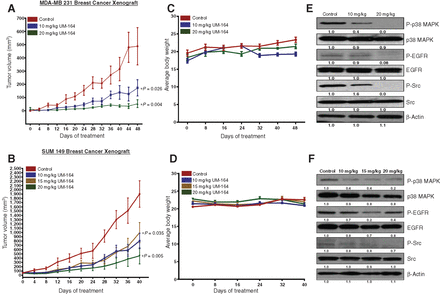This product is for research use only, not for human use. We do not sell to patients.

| Size | Price | Stock |
|---|---|---|
| 250mg | $1480 | Check With Us |
| 500mg | $2350 | Check With Us |
| 1g | $3525 | Check With Us |
Cat #: V3287 CAS #: 903564-48-7 Purity ≥ 98%
Description: UM-164, a dasatinib analogue, is a potent and dual inhibitor of the Src/p38 kinase with potential anticancer activity for Triple-Negative Breast Cancer (TNBC). It is a promising lead compound for developing the first targeted therapeutic strategy against TNBC. c-Src has been shown to play a pivotal role in breast cancer progression, metastasis, and angiogenesis. In the clinic, however, the limited efficacy and high toxicity of existing c-Src inhibitors have tempered the enthusiasm for targeting c-Src. UM-164 binds the inactive kinase conformation of c-Src. Kinome-wide profiling of UM-164 identified that Src and p38 kinase families were potently inhibited by UM-164. UM-164 alters the cell localization of c-Src in TNBC cells. In xenograft models of TNBC, UM-164 resulted in a significant decrease of tumor growth compared with controls, with limited in vivo toxicity.
Publications Citing InvivoChem Products
Product Promise

- Physicochemical and Storage Information
- Protocol
- Related Biological Data
- Stock Solution Preparation
- Quality Control Documentation
| Molecular Weight (MW) | 640.69 |
|---|---|
| Molecular Formula | C30H31F3N8O3S |
| CAS No. | 903564-48-7 |
| Storage | -20℃ for 3 years in powder formr |
| -80℃ for 2 years in solvent | |
| Solubility In Vitro | DMSO: 10mMr |
| Water:r | |
| Ethanol: | |
| SMILES Code | O=C(C1=CN=C(NC2=NC(C)=NC(N3CCN(CCO)CC3)=C2)S1)NC4=CC(NC(C5=CC=CC(C(F)(F)F)=C5)=O) =CC=C4C |
| Synonyms | UM-164; UM 164; UM164 |
| Protocol | In Vitro | In vitro activity: UM-164 is a potent Src/p38 inhibitor with potential anticancer activity for Triple-Negative Breast Cancer (TNBC). It is a promising lead compound for developing the first targeted therapeutic strategy against TNBC. c-Src has been shown to play a pivotal role in breast cancer progression, metastasis, and angiogenesis. In the clinic, however, the limited efficacy and high toxicity of existing c-Src inhibitors have tempered the enthusiasm for targeting c-Src. UM-164 binds the inactive kinase conformation of c-Src. Kinome-wide profiling of UM-164 identified that Src and p38 kinase families were potently inhibited by UM-164. UM-164 alters the cell localization of c-Src in TNBC cells. In xenograft models of TNBC, UM-164 resulted in a significant decrease of tumor growth compared with controls, with limited in vivo toxicity. Kinase Assay: UM-164 is a potent and dual inhibitor of the Src/p38 kinase with potential anticancer activity. UM-164 binds the inactive kinase conformation of c-Src. Kinome-wide profiling of UM-164 identified that Src and p38 kinase families were potently inhibited by UM-164. Cell Assay: MDA-MB 468 cells were trypsinized and allowed to adhere overnight to #1.5 cover glass in a 6-well plate. Cells were then treated with 5 μmol/L dasatinib, 5 μmol/L UM-164, or vehicle (DMSO) for 4 hours. Cells were then fixed with 4% paraformaldehyde for 15 minutes at room temperature followed by three washes with PBS. The fixed cells were treated with 1 μmol/L of an irreversible turn-on Src fluorophore for 1 hour followed by three washes with PBS. Cells were then mounted on slides with UltraCruz Hard-set Mounting Medium w/DAPI (Santa Cruz Biotechnology; sc-359850) and stored for 30 minutes at 4°C in the dark. |
|---|---|---|
| In Vivo | In xenograft models of TNBC, UM-164 resulted in a significant decrease of tumor growth compared with controls, with limited in vivo toxicity. | |
| Animal model | NCr/nude mice, 6 weeks of age | |
| Formulation | Dissolved in a mixture of DMSO/propylene glycol (1:9) | |
| Dosages | 10 mg/kg, 15 mg/kg, or 20 mg/kg; i.p. injection |
| Solvent volume to be added | Mass (the weight of a compound) | |||
|---|---|---|---|---|
| Mother liquor concentration | 1mg | 5mg | 10mg | 20mg |
| 1mM | 1.5608 mL | 7.8041 mL | 15.6082 mL | 31.2163 mL |
| 5mM | 0.3122 mL | 1.5608 mL | 3.1216 mL | 6.2433 mL |
| 10mM | 0.1561 mL | 0.7804 mL | 1.5608 mL | 3.1216 mL |
| 20mM | 0.0780 mL | 0.3902 mL | 0.7804 mL | 1.5608 mL |
This equation is commonly abbreviated as: C1 V1 = C2 V2
- (1) Please be sure that the solution is clear before the addition of next solvent. Dissolution methods like vortex, ultrasound or warming and heat may be used to aid dissolving.
- (2) Be sure to add the solvent(s) in order.









































